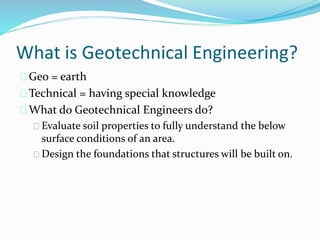The 15-Second Trick For Geotheta
The 15-Second Trick For Geotheta
Blog Article
Some Known Facts About Geotheta.
Table of ContentsHow Geotheta can Save You Time, Stress, and Money.The Ultimate Guide To GeothetaThe 3-Minute Rule for GeothetaGeotheta Can Be Fun For Anyone
They collaborate with civil designers, architectural designers, engineers, and various other experts to incorporate geotechnical factors to consider right into the overall project style and construction process. This requires efficient synergy, sychronisation, and interaction to guarantee that the geotechnical elements line up with the task goals and fulfill regulatory requirements.Mining & Products Engineering: Principles of drilling, penetration rates, and variables affecting the choice of exploration method. Characteristics of nitroglycerins, shooting systems and blast patterns. Blowing up methods in surface and underground operations. Unique blasting methods at excavation boundaries. Vibration and noise control. Mechanical and continual methods to fragmentation, consisting of longwall shearing and fullface boring.
Integrated analysis of fragmentation and comminution procedures. Provided by: Mining & Products Engineering.
Some Known Facts About Geotheta.
Bachelor's degree programs in civil, geotechnical, geological, and ecological design generally last four years and consist of general education and learning programs in English, social science, and the humanities, in addition to courses in sophisticated maths, structural geology, and liquid mineralogy. (https://www.anyflip.com/homepage/zuylo)
Geotechnical design includes the evaluation of the dirt and rock problems at a particular site, and their implications for the advancement of that website. As most structures rely upon the ground for assistance, it is without surprise that an in-depth understanding of the ground conditions, and the viability of structure systems, are crucial to the lasting stability and efficiency of the structure or structure.
Specialising in the investigation of geological formations and ground practices, geotechnical designers perform scientific examinations and testing to recognize the influence these geological formations may carry the design and building and construction of structure, civil and framework projects. This proficiency is essential for the design and construction of buildings, roads, tunnels, dams, bridges, and water and sewer system.
The geotechnical group at Douglas Allies routinely talk to engineers, style engineers, designers, and builders to make suggestions on design and advancement propositions to make sure that the constructed structures are accordingly created for the ground conditions. The layout of footing systems requires to consider the weight of the structure, the capacity of the ground to sustain that weight with each other with activity tolerances and effective building and construction.
Top Guidelines Of Geotheta
This task is considerably streamlined by the use our Douglas Map geospatial platform that makes this information readily easily accessible in a simple to make use of web browser interface. A geotechnical designer will direct the drilling of boreholes and test pits to collect dirt and various other samples, and additionally analyze surface area features and ground exposures to develop a geotechnical version of the subsurface conditions.
Depending on the task type and ground problems encountered, laboratory screening might to name a few points evaluate strength, compressibility, sensitivity and/or permeability of dirt and rock examples. After this information is collected and looked at, the results are utilized for a geotechnical version of the website, which is commonly offered as areas across the site.

A geotechnical examination by nature can only evaluate the ground conditions at the locations pierced or dug deep into. All-natural variants in dirt and rock conditions can take place throughout a site and between test locations. It is as a result great method that the geotechnical designer be preserved throughout building and construction of the job to supply on-site confirmation that the ground problems come across are consistent with the expectations and suggestions given in the geotechnical investigation record.
Fascination About Geotheta
Geotechnical designers use their comprehensive knowledge of soil and rock to analyze threat and address problems on varied framework projectsGeotechnical engineering is a specialist branch of civil design which takes a look at the behaviour of earth materials and the application of soil and rock auto mechanics. Consulting Engineers. As a geotechnical designer, you will examine the physical, mechanical and chemical residential properties of soil and rock in order to create foundations, preserving frameworks and earthworks
Geotechnical design is carefully linked to and overlaps with, both engineering geology and ground engineering - https://disqus.com/by/geotheta/about/. It's feasible to be experts in geotechnics original site or benefit a geotechnical business yet be called a design geologist or a ground engineer. As a geotechnical designer, you'll need to: build and maintain connections with clients and other professionals associated with the site, throughout each projectmaintain safety and security requirements on site bear in mind expense implications when you make recommendationsstudy geological maps and airborne pictures from a variety of resources and from various time periodsexamine building and construction prepares to see just how possible they are based upon your understanding of the siteinvestigate risks or geological risks for the sitesearch for environmentally sensitive functions, such as landfill start to create factual and interpretive ground modelsplan field investigationsdrill and evaluate examples of bedrock, dirt, groundwater and added products supervise various other experts on sitesolve technical concerns as they arise, such as unexpected frameworks at drill sitesmonitor conditions during and after building to ensure frameworks are secure in the brief and lengthy termadding information accumulated on site to your preliminary researchcreating geotechnical calculations, illustrations, and 2 or three-dimensional computer system versions translating the datamaking suggestions regarding the suggested use of the site

Report this page